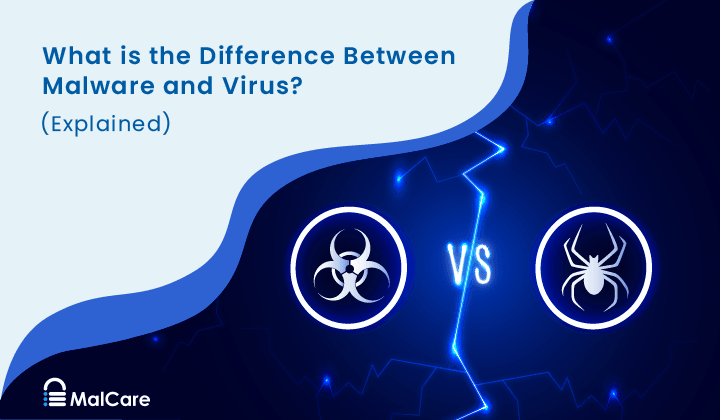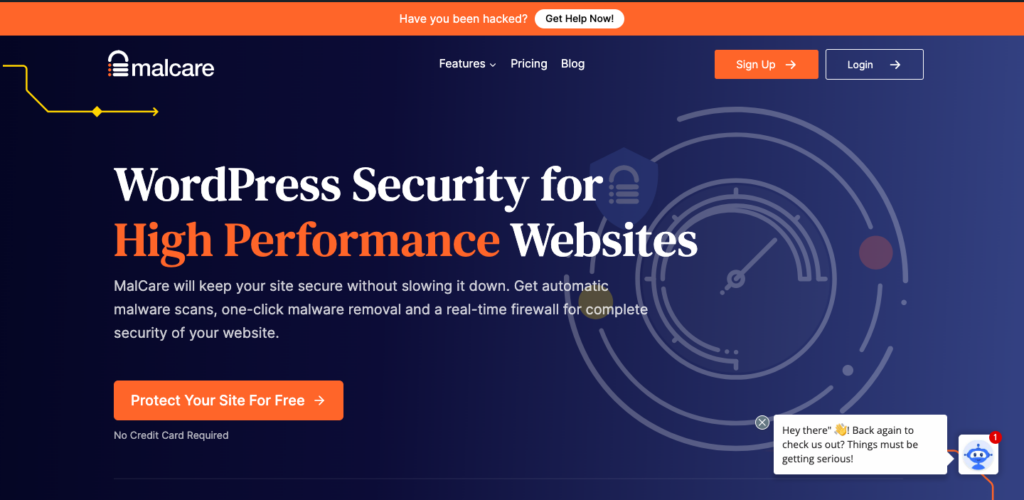What Is the Difference Between Malware And Virus? (Explained)
by
7-layers of Security for Your WordPress Site
Your website needs the most comprehensive security to protect it from the constant attacks it faces everyday.

The terms virus and malware get thrown around and used interchangeably a lot. But are they the same thing? Not quite. Not all malware is a virus but all viruses are malware. So, what differentiates viruses from other malware?
Understanding that difference can help you take the right measures to prevent an attack. You can also communicate with developers or professionals that can help you fight it. It’s also always helpful to be educated about what could go wrong, when you’re in charge of your site’s security.
If you suspect your WordPress site has malware, you need to scan it right away.
Whatever your reason for looking for this article, you’re in the right place. This article will simplify the terms, give you a comprehensive understanding and dive into topics like preventing malware attacks.
TL;DR: Viruses are one of many types of malware. Malware, in turn, is an umbrella term for malicious code that can harm your website. Both are serious threats, but can be prevented or mitigated using a comprehensive security plugin like MalCare.
What is the difference between malware and virus?
Virus and malware have overlapping features, similar impact and are both pretty complex. In this section, we’ll discuss the nuances and differences between the terms malware and viruses.
Virus
- A virus is a specific type of malware that is designed to replicate and spread itself to other parts of the website or other websites. One of the harder types of malware to remove.
- Can cause a range of problems, such as slowing down the website, causing it to crash, or stealing sensitive information.
- Typically requires user interaction, like clicking an email, and affects mostly computer systems.
Malware
- Malware is a general term that refers to any type of malicious software that can infect a WordPress website or computer system. It includes spyware, adware, and other types of malicious software in addition to viruses.
- Can be used to steal sensitive information, display unwanted ads, or take control of a website. Can also slow down a site or cause it to crash.
- Only requires vulnerabilities in cyber security systems and can affect a website or a computer.
What are the different types of malware?
Now that you have a better understanding, let’s talk about the different types of malware and some examples of how they work.
- Virus: Let’s start with the one you came here for. The WP-VCD malware acts a lot like a virus.
- Trojan: A trojan is a type of malware that disguises itself as a legitimate program, but once installed, it can perform malicious actions such as stealing sensitive information, deleting files, or opening a backdoor on the system. One example of a Trojan malware affecting WordPress sites was the TimThumb vulnerability
- Bot: A bot is a type of malware that uses automatic scripts for malicious activities like gaining login access or spam content. An example is the Mirai botnet, which infected IoT devices and used them to launch DDoS attacks on various websites, including WordPress sites.
- Ransomware: Ransomware is a type of malware that encrypts a victim’s files and demands payment in exchange for the decryption key.
- Worms: Worms are a type of malware that spreads from one computer to another by exploiting vulnerabilities in software. While worms are less common on websites, they can still infect WordPress sites if a user clicks on a malicious link or downloads a worm-infected file.
- Adware: These programs display unwanted advertisements and collect user data without consent.
- Spyware: These programs collect user data without consent and send it to remote attackers.
How does virus or malware attack your website?
Now that we’ve talked about what a virus or malware is, here is what goes into an attack:
- The attacker identifies a vulnerability in the website’s software or server, such as outdated software, weak passwords, or open ports. In WordPress, vulnerabilities are found in plugins and themes, and sometimes even in core WordPress.
- The attacker gains access to the website by exploiting the vulnerability. This can be done through techniques such as SQL injection, cross-site scripting (XSS), or brute-force attacks on login pages.
- The malware or virus can then be used to perform a variety of malicious actions, such as stealing sensitive data, redirecting visitors to malicious websites, or installing additional malware on visitors’ computers. The attacker can also use the infected website to launch further attacks, such as phishing campaigns or distributed denial-of-service (DDoS) attacks.
How do you prevent malware and virus attacks on your site?
We briefly talked about the damage a malware attack can do to your site and it is pretty terrifying. So it’s much better to prevent attacks than to deal with the consequences of an attack. Here are some effective ways to protect your site from malware and virus attacks:
- Install a firewall: A firewall acts as a barrier between your website and the internet, blocking unwanted traffic and keeping your website safe from attacks. MalCare’s top notch firewall is able to efficiently monitor for malicious traffic and detect suspicious behavior.

- Safely update plugins and themes: Regularly updating your website’s software, plugins, and themes ensures that any known security vulnerabilities are patched and reduces the risk. Make sure that you are using staging to safely update them.
- Use strong passwords: This might feel like an obvious answer but it is an often-overlooked security protocol. Weak passwords are easy targets for hackers. Use strong, complex passwords and consider using a password manager to keep them secure.
- Backup regularly: Taking a backup should become second nature to you, as a site admin. Regularly backing up your website ensures that you can restore it with minimal data loss.
- Monitor for security risks: Keep an eye out for any suspicious activity on your website, such as strange login attempts or unexpected changes to your website’s code. Use a security plugin like MalCare to scan for malware and other security risks regularly. We’ve tested other security plugins like iThemes and Wordfence but MalCare has come out on top, for its scanning capabilities.
What to do if you’ve been attacked by malware or virus?
If your security system has failed to keep out malware from your WordPress site, the first step is to scan for it. You can use a security plugin like MalCare to scan for free. If the scan (and any other diagnostics you may have conducted) shows that you’re under attack, the next step is to recognise that it is fixable. Here are some things that you can do:
- Remove the malware: There are three methods you can use to remove the malware as seen below:
- Automatic removal: This is by far the easiest. Install MalCare and scan your site. You can remove the malware with little to no downtime. Speed is of the essence here and with MalCare you can remove it all in minutes.

- Hire a WordPress developer or expert: You can also hire an expert. This is a viable option if the malware is present in core files that require special attention. Though, it must be noted that maintenance services aren’t quick or cheap. On the other hand, you have unlimited access to a team of security experts at MalCare, once you upgrade the plugin.
- Manual malware removal: In all honesty, this is the worst method. It’s unreliable, difficult, and time-consuming. It requires a lot of technical knowledge too. But, if you’re looking for a manual method, you will have to download the clean versions of your website’s files, compare them to your corrupt files, identify the malicious code and remove it. Unfortunately, there is no formula for identifying malware and not all differences are malicious. Sometimes, it’s just customizations. Like we said, it’s time-consuming.
- Change passwords: If your social media has ever been hacked, you’ll be familiar with this. Changing your passwords reduces the access that hackers have to your site. Be careful to change all passwords: site, database, cPanel, hosting, etc.
- Scan for malware again: Once you have cleaned your site, you should scan your site for malware again to ensure that all malicious code has been removed. While there are many security plugins available, MalCare has one of the best malware scanners.
- Notify users: If your site has been infected with malware, it’s important to notify your users that their personal information may have been compromised. This can be done through email or by posting a notice on your site’s homepage.
Why do websites get targeted?
The motivations behind website attacks can range from financial gain to political or social objectives. In this section, we will help you understand more:
- Financial gain: Hackers may target websites with the aim of stealing sensitive information such as credit card details, login credentials, or other financial information that can be sold on the dark web or used for fraudulent activities.
- Ransomware: This type of attack involves malware that encrypts a website’s data and demands payment for the decryption key. Ransomware attacks can be very lucrative for hackers and can lead to significant financial losses for website owners.
- Political or social motivations: Some attackers target websites with a political or social agenda, aiming to disrupt operations or spread propaganda.
- Reputation damage: Attackers may seek to damage a website’s reputation by defacing pages, spreading false information, or stealing sensitive data and publicly releasing it.
- Botnet attacks: Botnets are networks of infected computers or devices that are controlled by a hacker. These can be used to launch attacks on websites, such as Distributed Denial of Service (DDoS) attacks, which overwhelm the website with traffic and cause it to crash.
- Vulnerabilities: Websites with known vulnerabilities, such as outdated software or weak passwords, are particularly susceptible to attack. Attackers can exploit these vulnerabilities to gain access to the site and carry out various types of attacks.
How does a virus or malware attack impact your site?
The impact of virus and malware attacks on websites can be devastating. We grazed over this subject earlier but in this section, we’ll explore it in more detail:
- Loss of data: Viruses and malware can corrupt, modify, or delete important data from your website, causing a loss of information that may be difficult or impossible to recover.
- Website downtime: An attack can cause your website to crash, resulting in extended periods of downtime that can lead to a loss of revenue and visitors.
- Loss of credibility: A compromised website can negatively impact your brand’s reputation and customer trust, especially if sensitive information is stolen.
- Blacklisting: If your site is infected with malware, it can get blacklisted by search engines, resulting in your site’s removal from search engine results pages.
- Financial consequences: Security breaches can lead to lost revenue, legal fees, and other financial consequences that can be detrimental to your business.
Final thoughts
In today’s world, cyber security is an essential part of managing a website. The constant threat of viruses and other types of malware make a security plan a necessity. Security plugins like MalCare make it significantly easier to protect your site from these threats. MalCare has features like automatic scanning, malware removal, and brute-force protection that ensures that your website stays safe.
FAQs
- What is the difference between malware, virus and spyware?
Malware is a broad term that refers to any type of malicious software designed to harm or exploit computer systems or networks. A virus is a specific type of malware that spreads by infecting files and other programs. Spyware is another type of malware that secretly collects and transmits sensitive information about a user’s computer activities to a third party.
- What are the 3 types of viruses?
There are many different types of viruses, but here are three common ones:
- Boot sector viruses: These infect the master boot record of a hard drive, making it difficult or impossible to boot up the computer.
- File infectors: These attach themselves to executable files on a computer and spread when those files are opened.
- Macro viruses: These infect files such as Microsoft Word documents and use the macro programming language to execute their code.
- What is an example of a virus and malware?
An example of a virus is the Melissa virus, which spread via email attachments in 1999 and caused widespread disruption. An example of malware is the WannaCry ransomware, which infected hundreds of thousands of computers worldwide in 2017 and demanded payment in exchange for unlocking the encrypted data.
- Is a Trojan a virus or malware?
A Trojan, also known as a Trojan horse, is a type of malware that disguises itself as legitimate software to trick users into downloading and installing it. Trojans can be used to steal sensitive data, such as passwords and financial information, or to gain remote access to a victim’s computer. While a Trojan is a type of malware, it is not classified as a virus because it does not replicate itself.
- Is all malware a virus?
No, not all malware is a virus. Malware is an umbrella
Share it:
You may also like
![Top 9 ManageWP Alternatives To Manage Multiple Sites Easily [Reviewed]](https://www.malcare.com/wp-content/uploads/2022/12/malcare-default-image.jpeg)
Top 9 ManageWP Alternatives To Manage Multiple Sites Easily [Reviewed]
ManageWP is a popular name in the WordPress maintenance plugins market. People love how much you get for a free plan, how easy it is to set up, and how…

MalCare Proactively Defends Against Icegram Express SQL Injection Vulnerability
MalCare’s recent data has revealed numerous attempts to exploit a newly found SQL injection vulnerability in the Icegram Express plugin. Attackers commonly use this sophisticated SQL injection technique to extract…

Atomic Security’s Deep WordPress Integration Helps Protect Against Core XSS Vulnerability
The recent WordPress core vulnerability is a critical one, primarily because of two reasons. Firstly, it affects the WordPress core itself, which means that every WordPress site is vulnerable to…
How can we help you?
If you’re worried that your website has been hacked, MalCare can help you quickly fix the issue and secure your site to prevent future hacks.

My site is hacked – Help me clean it
Clean your site with MalCare’s AntiVirus solution within minutes. It will remove all malware from your complete site. Guaranteed.

Secure my WordPress Site from hackers
MalCare’s 7-Layer Security Offers Complete Protection for Your Website. 300,000+ Websites Trust MalCare for Total Defence from Attacks.








